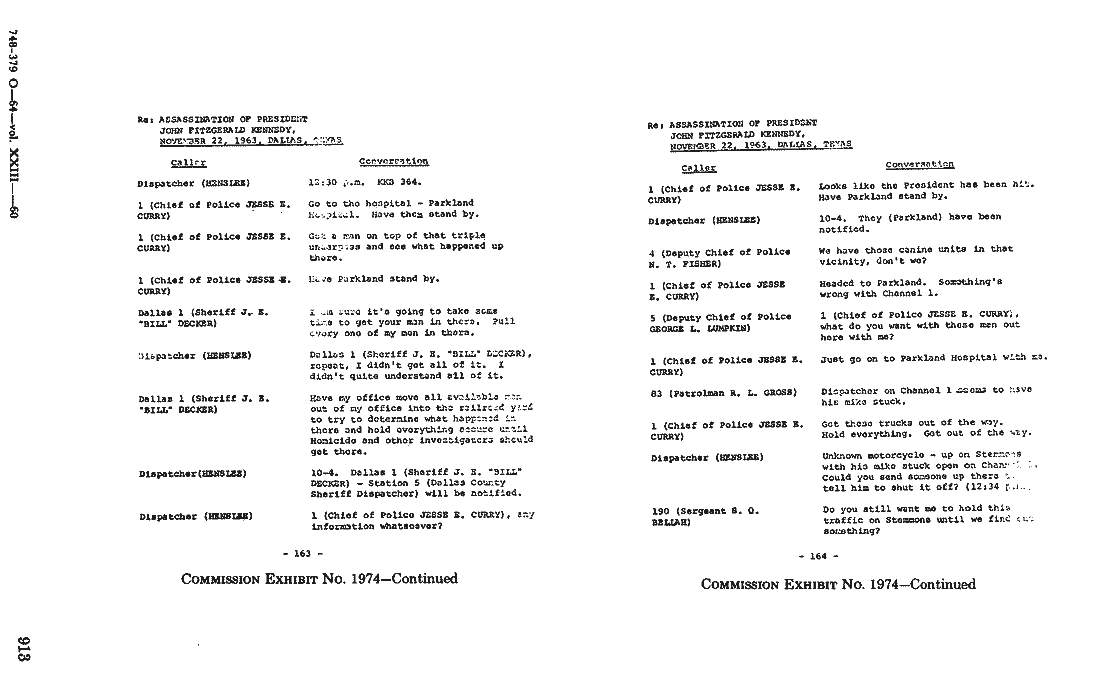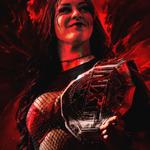@Pandorum @rgnf Ich möchte noch einmal die Sicherheitsanomalien auflisten, die hier nicht oder wenig diskutiert wurden
Die Punkte sind iesem Artikel entnommen:
http://mcadams.posc.mu.edu/palamara/boring_arrb.htmlSecurity Stripping #4
Will Fritz's men out of the motorcade:
Seth Kantor's notes----"Will Fritz's men called off night before by SS.
Had planned to ride closed car w/ machine guns in car behind Pres." [which
could mean someplace behind JFK's car, as was the case in Chicago, IL, on 3/23/63 and in
New York on 11/15/63]70
Security Stripping #5
Other vehicle shuffling:
Milton Wright, Texas Highway Patrolman (driver of Mayor Cabell's car)---
"As I recall, prior to the President arriving at the airport we were already
staged on the tarmac. I do not recall what position I was in at that time but
it was not #1[the number taped to his car's windshield]. At the last minute
there was a lot of shuffling and I ended up in the 5th vehicle. My vehicle was
the last to leave downtown after the shooting because the police set up a road
block behind my car."71
Secret Service Agent Roger Warner stated in his report that, while at
Love Field during the forming of the motorcade, "I undertook duties to aid SA
Lawson...in lining up cars for the motorcade, passing out numbers for the
automobiles, and other general duties..."72
During an interview conducted on 9/27/92, Lawson confirmed his handling
of the automobile numbers and identification pins in Dallas on 11/22/63.
When we consider that a number of the vehicles - including the
Presidential limousine - were out of their original, numerical order, the
trail of suspicion leads to these two men.73 Lawson was in charge of the "car
numbers for the windows" at Love Field. 74
There was even more security stripping attributed to the Secret Service.
The Secret Service "prevented the Dallas Police Department from inserting into
the motorcade, behind the Vice-Presidential car, a Dallas Police Department
squad car containing homicide detectives. Agent Lawson didn't know who
canceled the Dallas Police Department car...
Security Stripping #6
Personnel shuffling: an addition, and subtracting people from where they
normally would beGeneral Godfrey McHugh (rode in VIP car)--- was asked to sit in a car
farther back in the motorcade, rather than "normally, what I would do between
the driver and Secret Service agent in charge of trip"- he admitted this was
"unusual";75 "Ordinarily McHugh rode in the Presidential limousine in the
front seat. This was the first time he was instructed not to ride in the car
so that all attention would be focused on the President to accentuate full
exposure."76
Lt. Col. George Whitmeyer (rode in pilot car)--- "Mr. Lawson acknowledged
that Lt. Col. George Whitmeyer, who was part of the Dallas District U.S. Army
Command, who Lawson said "taught Army Intelligence" and who rode in the pilot
car, "wasn't scheduled" to be in the motorcade. [as 17 H 615, Lawson's
scheduled motorcade list, bears out]. Mr. Lawson denied that the presence of
Col. Whitmeyer had anything to do with Lawson's prior service in the CIC, Army
Counter Intelligence Corps."77; "My father passed away in 1978 and therefore
the answers to your questions are somewhat based on personal recollection of
his information given to me. In regards to your first question, my father was
invited by Col. George Lumpkin (ret.) (deceased) to ride in the point [sic]
car of the motorcade. He was not a scheduled participant. I think that Col.
Lumpkin was with the Dallas Police Department at the time."78
Security Stripping #7
Motorcade route: largely kept secret, even from the Dallas police. Changes
made to it.DPD Chief Jesse Curry---testified that he was not even consulted about
the motorcade route!79; learned of the route 11/21/63 via agents' Win Lawson
and Forrest Sorrels.80
DPD Asst. Chief Charles Batchelor---"From an administrative standpoint,
(DPD's Charles) Batchelor believed that the failure of the Secret Service to
inform the police adequately in advance of the exact route to be taken by the
president prevented them from adequately organizing their men and taking the
necessary security precautions."81
DPD Sergeant Samuel Q. Bellah, one of the three advance motorcycle
officers in the motorcade---"On the night before his assignment, Bellah
reviewed the planned route with his captain. The route was not the original
one that was to go straight through Dealey Plaza, but a revised route. The
original plan would have skirted the Texas Book Depository building by a
block, but the altered plan turned to pass directly in front of the
building."82
DPD motorcycle officer Bobby Joe Dale--- "Two or three days prior to the President's visit we'd ridden with the Secret Service checking to see where the turns and problem areas might be. We had three possible
routes, but we didn't know which one we were going to take, and we were not briefed on it. But
by riding during the week, I kept hearing the phrase "escape routes," which dawned on me
later that should something happen to any part of the motorcade we had an escape route to either
Baylor or Parkland Hospitals...Once we were assembled and the President was ready to go, we
started the motorcade by going out a gate at the far end. At that time, we didn't know which
route we were taking; we had three: right, straight, or left. As we were leaving, the word came
over the radio that we would use the particular route that went left. ["No More Silence" by Larry Sneed (1998), pp. 132-133]"
Governor John Connally---stated that he was never informed about the
exact route to be used on the day of the assassination 83
DNC advance man Marty Underwood told Harrison Livingstone: "There were so many things that fell through in Dallas. Any advance man who had any sense at all would never have taken him down that route." When Livingstone commented that the route was changed, Underwood added: "YEAH, I KNOW. You don't take a guy down a route like that."("High Treason 2", by Harry Livingstone, page 442: emphasis added)
SAIC Jerry Behn---(regarding his unpublished, executive session testimony
before the HSCA) Behn told the author that he was asked two things: first,
the details about the Florida trip of November 18, 1963; second, why the
motorcade route was changed for the Dallas trip! When the author inquired
about the second point since it is another crucial matter of security, Behn
responded: "I know it was changed but why - I've forgotten completely - I
don't know."84
Security Stripping #8
Overpass not cleared/ protected properly:Winston G. Lawson----"I recall thinking we were coming to an overpass
now, so I glanced up to see if it was clear, the way most of them had been
,THE
WAY ALL OF THEM HAD BEEN UP UNTIL THAT TIME ON THE WAY DOWNTOWN, AND IT WAS
NOT...And I was looking for the officer WHO SHOULD HAVE BEEN THERE, HAD BEEN
REQUESTED TO BE THERE...and I made a kind of motion through the windshield
trying to get his attention to move the people from over our path THE WAY IT
SHOULD HAVE BEEN...we were just approaching this overpass when I heard a
shot." [emphasis added].85Security Stripping #9
Buildings along the motorcade route not checked at all. Lawson told both the Warren Commission and the House Assassinations
Committee that
he could not recall giving instructions to watch building
windows, "although it was his usual practice to do so". Dallas Police Captain
Lawrence confirms that no instructions were given.86
Man sollte auch nicht vergessen, dass JFKs Leibarzt Dr. George Burkley einen Platz weit hinten in der Wagenkolonne zugeteilt bekam, was sofortige medizinische Hilfe bei JFK unmöglich machte...
Burkley said he virtually always rode in close proximity to the president. He could think of only one previous exception, the visit to Rome in July of 1963. But in Dallas, he was actually relegated to a bus at the rear of the motorcade. (ibid, p. 142) This, of course, delayed his reaction time in getting to the president. Towards the end of this discussion of the out of order cars, and passengers, Palamara then drips in another interesting tidbit. It was Lawson who was in charge of the car numbers for the motorcade. (p. 143) The author says these changes occurred somewhere between November 19th and the 22nd. And Lawson tried to pass them off to advance man Jack Puterbaugh. (ibid) But Palamara writes, Puterbaugh never made any mention of any such responsibility on his part. HSCA attorney Belford Lawson again summed the situation up well: "Why was there so much juggling around and controversy about seating at Love Field, and why was there so much constant repositioning and shuffling of dignitaries' cars in relation to press cars during the Texas trip?" Lawson then added another tantalizing question: "Why was the [Dallas] motorcade longer than any other motorcade on the Texas trip?" (ibid, p. 144)
https://kennedysandking.com/john-f-kennedy-reviews/palamara-vincent-m-survivor-s-guilt
bredulino schrieb:1. schreib doch einfach, dass du Dutzende Aussagen von Secret-Service-Beamten, inklusive Secret-Servie-Chefs, bewusst ignorierst, um deine Agenda aufrechtzuerhalten dass Kennedy den Secret Service bei Sicherheitsmaßnahmen herumkommandieren konnte und gut ist
bredulino schrieb:3. schreib doch einfach dass du viele Aspekte in Dallas einfach ausblendest um weiter behaupten zu können dass es dort nicht mehr Pannen gegeben hätte als anderswo
bredulino schrieb:Das zeigt dass du Quellen nicht gelesen hast.
bredulino schrieb:Und im Fall Kennedy ist das so oder so irrelevant da er sich brav den Anweisungen des Secret Servie fügte und diesem freie Hand ließ.
bredulino schrieb:Shreib doch einfach, dass der Secret Service in Dallas ein einmaliges Totalversagen hatte und die Verantwortung trug und gut ist






